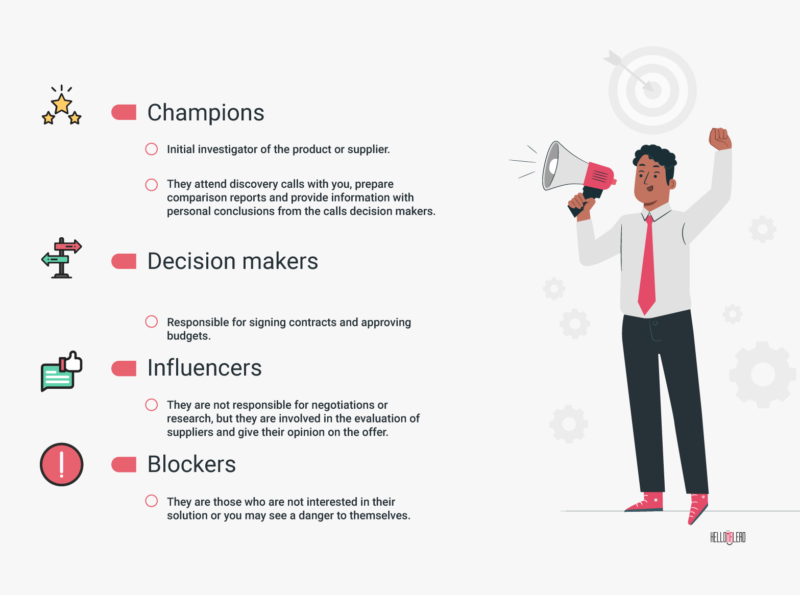A customer is a customer. Any sale is a good sale» is a very common mistake among many marketers and marketers who believe they should cater to everyone, so today we show you how a good lead qualifies and why it is important to consider your target to move towards the right path with your company.
Index
- Sell to the wrong people, a customer who will never come back in the future.
- What is the ideal customer profile (ICP)?
- Some mistakes that are made developing ICP
- Importance of an ideal customer profile.
- The main purposes of the ideal customer profile.
- Difference between an ideal customer profile and buyer people.
- The purchasing committees and their internal roles.
- Benefits of defining the purchasing committee.
- Characteristics of the purchasing committee.
- The basic elements of the ideal customer profile.
- Target resources.
- Conclusion.
1. Selling to the wrong people, a customer who will never return in the future
Most companies spend a considerable amount of resources on acquiring and converting customers in the hope that they will remain profitable for years. To generate revenue you need to create a successful marketing and sales strategy and keep buyers in the forefront.
Every product or service has ideal customers and not so much, selling to the wrong people will cause difficulties to connect with these in the future, in fact, if you keep operating under the assumption that everyone needs what you offer, it will be very difficult for your future conversions to appreciate the value of your products, services or content since it will not be focused on their real interests.
The magic ingredient for a successful sales and marketing strategy is a well-defined ideal customer profile, in addition to building an IPC (ideal customer profile), suitable that ensures that its new users feel valued and supported, This will help determine if existing ones fit well into your long-term business (reducing the dropout rate).
2. What is the ideal customer profile (ICP)?
An ideal customer profile (ICP) includes information about individuals in a company who would seek to make the most of their product or service, defines the prospects and the most valuable ones they are most likely to buy.
Simply put, an ideal customer profile is a list of attributes that your best buyers from a specific market segment have in common whose goal is to focus on selling to people who fit the capabilities of your products/services.
Regarding these attributes, we could divide them into two fundamental factors:
- Standard attributes include revenue, team size, subsidiaries, geographic locations, technology stack, and advertising spending, among others.
- Non-standard attributes: on the other hand, there are attributes that are particular to each business and being unique cannot be standardized.
In general, these are quantitative and qualitative analyses based on data from various organizational sources to create a strategic document, creating a client or focused ideals. Knowing who really needs you and going the right way to that loyalty is of great importance.
3. Some mistakes made in developing PCI
It is important to note the mistakes that most B2B professionals make when developing their PCI, such as:
- Forget that each segment is unique.
Defining an ICP is the equivalent of tracing a segment that has individual needs and particular reasons that lead them to consume a product or service, because of this, it is advisable to create separate ICP for different market segments.
- Don’t focus on your best customers.
As previously mentioned, each person is different, if you combine and mix all the data of your customers, you will only have as a result a universal audience that fits in a “unique size” for anything strategic, use the data assertively so you’ll create more personalized content.
4. Importance of an ideal customer profile
Running a business without having an ideal customer profile will not yield fruitful results, success involves having lasting relationships with people and that is only possible by addressing the right ones.
If you do not have an ideal target profile, you will end up focusing your efforts in different areas of the market, in turn, your sales and marketing representatives will be behind potential customers who will never buy you, that could result in a waste of time, money and effort on the part of the commercials.
5. The main purposes of the ideal customer profile
- Focus on
The ICP helps focus your marketing and sales team on prospecting for high quality accounts rather than pursuing the entire market. As a result, your company generates better opportunities with a much higher average value of deals and reaches the revenue quota more often.
- Customize
You’ve heard all your life about the importance of personalization, but what does «personalization» really mean?
It’s a process of adjusting marketing to a particular group of customers, so they feel that this product is made for them. How can you achieve this level of customization? Adjusting all your marketing content, website, ads, landing pages to the needs, challenges and goals of your ideal buyers.
- Targeting leads generation channels
Should you advertise on LinkedIn? Or write a guest article on TechCrunch? Or attend the Berlin exhibition?
ICP’s goal is to eliminate these questions and help you define sales channels to generate more leads similar to your best customers, the only way to find out these channels is to conduct in-depth interviews with customers.
- Consider Marketing Rating Criteria (MQL)
The fourth purpose of the ICP is to find out the essential points for marketing qualification (MQL).
The marketing rating helps define whether the leads they generate from any marketing campaign fit your ideal persona profile and should be fed, transferred to sales, or if they should be disqualified.
6. Difference between ideal customer profile and buyer people
Marketing terminology often has concepts that are easy to confuse, which leads to the creation of strategies based on ignorance.
As a reminder, the first thing you should know is that the B2B sales experience cannot be addressed in the same way as the B2C. Therefore, the concepts are adapted to business environments and not to people.
So, all you need to know is that PCI for any B2B organization consists of two parts:
- Description of the ideal account (or client profile or ideal avatar).
The ideal account description is a list of features (such as income, equipment size, location) that you will use for qualification and prospecting.
- Purchasing Committee (or Buyer B2B People).
These are the working roles that usually influence their agreement within the accounts and objectives, tend to be categorized according to their tasks as: champions, decision makers, influencers and blockers.
7. Purchasing committees and their internal roles
It is a group of people who somehow influence their agreement within their target accounts, B2B marketers define four general functions within a purchasing committee, as are the following:

8. Benefits of defining the purchasing committee
There are several reasons why it is necessary to define the purchasing committee, these are the two fundamental advantages:
- You will avoid the «black box factor» and you can influence the purchase process (customer journey).
The «black box factor» is a situation in which you have made several discovery calls with the champion.
You see their enthusiasm, you get a consultation and you send the proposal in the hope of closing the deal, but then you hear a «no» without having any idea why you lost the deal.
When you know the typical structure of the purchasing committee, you can:
- Warm up all buying committee members.
- Prepare content that could motivate them.
- Commit to them in time.
2. You’ll improve the efficiency of your lead generation campaigns.
One of the biggest mistakes that marketers and MBDs often make is that they only target decision makers in medium-sized or large companies, forgetting, for example, Champions.
In addition, it is much easier to get a meeting with decision makers through the Champions, in fact, if a Champion sees the value of your solution, transparent personal benefits and company/department, you’ll get a lot of inside information.
At the same time you will know how to influence other members of the purchasing committee and close the deal successfully.
9. Characteristics of the purchasing committee
It is not logical to speak in the same way to the younger generation and those over 50, these two categories have values, decision processes and purchasing criteria totally different.
Consequently, it is important to adjust the marketing message according to its own characteristics, it is recommended to add working roles to identify a typical structure of purchasing committee within its best customers.
Just as it is impossible to market in the same way to different age groups, it is impossible to address stakeholders and middle management in the same way, each has different factors influencing its purchasing decision, value different kinds of benefits they can get from your product, and the reasons why they might reject your proposal are also different.
The best way to achieve better results is to analyze:
- The personal benefits that each of the purchasing committee members gets from your product,
- The reasons for blocking the deal.
- The objections or concerns you have encountered in dealing with them.
With this information gathered, you’ll be able to update all your marketing and sales content, improving the lead nutrition program to increase the number of qualified leads for sales.
10. The basic elements of the ideal customer profile
As we have mentioned, the data we need to create this profile are very different from the one taken into consideration when making a buyer persona of a B2C company, in this case, the information that is required must be adapted to the description of a company.
So the first thing to do when asking how to analyze the customer profile, we must take into account the following elements:
- Sectors, expand the leads
Once the target market segment is defined, you need to understand which subindustries generate more revenue and are more profitable for your business, Knowing them will help you create a better list of leads and update your positioning and value proposition accordingly.
- Location
Knowing the regions your most profitable customers reach will not only help you improve your prospecting, it will give you an essential insight on how to adjust your team’s schedule, if you are a European company and targeting American companies, do not forget the time difference.
So you need to adjust your customer service schedule and all of your marketing activities, such as outreach emails, social media newsletters, or ads, to your best buyers’ time zone.
Plus, it makes sense to get to know the parties and customs of your target market better. For example, you will not be able to reach anyone in Israel on Friday for Shabbat (the weekend in Israel is Friday and Saturday) or the people of the United States on the fourth Thursday of November (Thanksgiving Day).
If you want to focus a lot on a specific geomarket, research thoroughly, think about local representatives and location, you will be able to better know the unique characteristics of the market, the typical buying process, the factors that influence, the local resources used by its target audience and use them to their advantage.
- Annual income and equipment size
Revenue and team size are essential to narrow the focus, so when you know the revenue range and team size of your best customers, you can use data enhancement software like UpLead to make a relevant list of prospects.
- Your income
You should also add to the PCI the total revenue of each lead you will analyze, remember that we have mentioned that not all your customers are equal because, when the final PCI is developed, it is important to review the best revenue.
- Challenges
Companies hire you or buy your product to solve a specific challenge that they can’t do at the moment, either because of a lack of knowledge, resources or technology.
The most common case when companies hire me as a consultant is that they hit a revenue plateau, have no marketing experience, lost money on ads and outreach, and want to scale. They don’t want to keep experimenting and wasting time and money, but want someone with a solid track record to join their team as an extension, develop an exit strategy and create a marketing and sales machine.
- Reasons to buy
Why do your customers buy from you? Is it for a lower price, for niche positioning, for the content you publish or for case studies and testimonials? As with the challenges you solve, you can leverage the answer to this question to improve your unique value proposition.
During customer calls you could answer those questions, in this article about the perfect discovery call, you can get some interesting ideas.
- Strategic objectives
As with the challenges and reasons customers buy from you, you need to know what goals they want to achieve with your product or service. Startups don’t hire software development teams just to code, they want to have a partner who is able to understand the needs of the business and create an MVP that the market expects at an affordable price and term.
SaaS B2B companies do not hire digital agencies to create a website. So what do they need? Require a partner to create a website that converts t
SaaS B2B companies do not hire digital agencies to create a website. So what do they need? They require a partner to be able to create a website that turns traffic into free tests and conversions, the only way to know is by conducting in-depth customer surveys.
- Unique features
The unique features (or non-standard criteria) come from market segmentation, it can be a stack of technology, advertising expenses or what makes sense for your business.
For example, for a customer selling Fintech enterprise software, the unique features we selected were:
- Low profitability.
- Income.
- Costs operated in a volatile local currency.
11. Resources for assignment
Target resources are places your target audience visits regularly. They can be social media communities, blogs (such as the HelloMrLead blog), content curation platforms, or niche news portals (such as Hackernoon).
Target resources give you a clear view on:
- Where you can reach your target audience.
- What content your audience consumes and what content they demand.
- What social media you should use to build contacts and what social media you should avoid.
- As a result, you can avoid guesswork when working on a new marketing plan.
12. Conclusion
Lead capture is the central theme of B2B companies, however ignorance of concepts such as the Ideal Customer Profile causes the failure of their sales and marketing strategies.
By confusing them with definitions like the buyer persona, they lose sight of the actual data they require to target prospects that are closer to making the purchase, many are attracted to getting a large volume of customers, However, if these do not meet the conditions of an ideal buyer, however abundant your database and contact efforts, the sales will not reach the targets.
This is one of the cases where less, could be more. Targeting ideal customer profiles correctly will be more assertive and productive than launching a strategy for uninterested consumers.





